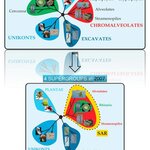Science category landing
Life Sciences

2-3 percent of children are born with mental retardation. It can sometimes be attributed to external factors (such as a shortage of oxygen at birth) or to defects in the DNA but, in 80% of the cases involving DNA, scientists do not know which genes are responsible.
Researchers at VIB, the Flanders Institute for Biotechnology, connected to the Katholieke Universiteit Leuven, in collaboration with an Australian research team, have discovered that, in a portion of these patients, the mental retardation is caused by a twofold production of two proteins (HSD17B10 and HUWE1). This is the first…

The Tree of Life has lost one of its branches due to the discovery that two formerly separated branches share a similar evolutionary history.
It's more than just re-drawing textbooks.
The discovery by Norwegian and Swiss researchers has gained attention from biologists worldwide. The findings come from the largest ever genetic comparison of higher life forms on the planet. Of 5000 genes examined, researchers identified 123 common genes from all known groups of organisms; these common genes have been studied more closely. The study has required long hours of work from the researchers and an…

Recently there has been some discussion in the blogosphere about student-advisor relationships in science. Some of this has been triggered by the article by Peter Lawrence in Current Biology (The mismeasurement of science) and some by the recent reports in Nature (here and here) regarding the comparatively low numbers of academic positions relative to the number of new PhDs (and be sure to see also Larry Moran's slightly different and perhaps more realistic take on this).
One of the recurring topics is the pressure that is often put on graduate students by their advisors to publish. Often…

Researchers at Oregon Health & Science University’s Neurological Sciences Institute have uncovered the system that tells the body when to perform one of its most basic defenses against the cold: shivering. Most interesting is that it's not the same sensory pathway as conscious cold detection.
Our bodies use two different but related sensory systems to conscious and subconsciously detect cold at the same time.
Shivering is one of the many automatic and subconscious regulatory body functions, often called homeostatic functions, that the brain regulates. Other examples include the…

An international team of scientists have sequenced the genome for Physcomitrella – the first non-flowering or ‘lower’ plant to be sequenced – and published their findings in the latest issue of Science.
The moss Physcomitrella patens is a primitive plant, similar to the first plants which began to grow on land around 450 million years ago. Just one cell thick, these early plants had to adapt to withstand cold, heat and drought without roots or complex leaves. The ability of mosses to survive severe dehydration and then regrow when watered could be of enormous use in crops grown in drought-…

Scientists at Imperial College London have overcome two significant obstacles on the road to harnessing stem cells to build patches for damaged hearts.
Presenting the findings at a UK Stem Cell Initiative conference 13 December in Coventry, research leader Professor Sian Harding explained how her group have made significant progress in maturing beating heart cells (cardiomyocytes) derived from embryonic stem cells and in developing the physical scaffolding that would be needed to hold the patch in place in the heart in any future clinical application.
Human embryonic stem-cell derived…

When a female is attracted to a male, entire suites of genes in her brain turn on and off, show biologists from The University of Texas at Austin studying swordtail fish.
Molly Cummings and Hans Hofmann found that some genes were turned on when females found a male attractive, but a larger number of genes were turned off.
“When females were most excited—when attractive males were around—we observed the greatest down regulation [turning off] of genes,” said Cummings, assistant professor of integrative biology. “It’s possible that this could lead to a release of inhibition, a transition to…

While the biological basis for homosexuality remains a mystery, a team led by University of Illinois at Chicago researcher David Featherstone has discovered that sexual orientation in fruit flies is controlled by a previously unknown regulator of synapse strength.
Armed with this knowledge, the researchers found they were able to use either genetic manipulation or drugs to turn the flies' homosexual behavior on and off within hours.
Featherstone, associate professor of biological sciences at UIC, and his coworkers discovered a gene in fruit flies they called "genderblind," or GB. A mutation…

Males with twin sisters are more likely to develop anorexia nervosa than other males, including males with a twin brother. Does exposure to female sex hormones in the womb increase the risk of getting it? If so, is anorexia a sex steroid hormone issue rather than strictly a psychological one?
“Anorexia nervosa is approximately 10 times more common in females than in males,” write study authors in the Archives of General Psychiatry. “The reasons for this difference are not known, and it is likely that their unraveling will represent an important step forward in the understanding of the…

A new species of bacteria discovered living in one of the most extreme environments on Earth could yield a tool in the fight against global warming.
In a paper published in Nature, University of Calgary biology professor Peter Dunfield and colleagues describe the methane-eating microorganism they found in the geothermal field known as Hell’s Gate, near the city of Rotorua in New Zealand.
It is the hardiest “methanotrophic” bacterium yet discovered, which makes it a likely candidate for use in reducing methane gas emissions from landfills, mines, industrial wastes, geothermal power plants…